Here is the Volume 2 of Curling from When you watch something, visit us first! Ms. Mika MATSUZAWA, who represented Japan in Curling at the 19th Olympic Winter Games in Salt Lake City, USA, 2002, told us about the Game plan of Curling this time. This is the combined version of Part 2-1 through 2-4 on our YouTube channel.
In Vol.1, we learned the basics of tactics of Curling.
This time, Ms. Mika MATSUZAWA, who represented Japan in Curling at the 19th Olympic Winter Games held in Salt Lake City, USA, in 2002, told us about the Game Plan of Curling.
I think you will understand how Curlers (Curling players) think about competing.
.png)
Part 2-1: Game plan for the early and mid-game
Now, let me talk about how to build Game plan from the 1st end to the 10th end of a Curling game.
Game plan for the early game
First is Game plan for the first 3 ends of the match, which are the early stages of the game.
In the early stages of the game, Curlers (Curling players) are still unsure of the ice conditions, so the 1st to 3rd end of the game is the time to focus on reading the ice conditions as well as getting a feel for the characteristics of their stones.
Of course, in the middle of the tournament, the players can get a better grasp of the ice conditions and how much the stones bend or slide, so they may attack from the earlier end, but basically, the theory is to get a firm grasp of the ice conditions and their stones early in the game, so the score often does not move that much. For example, 0-0 in the 1st end, and then score 2 points in the next 2nd end.

Therefore, in the early stages of the game, players do not move the game that much, but aim to read the conditions of the stones and ice.
Game plan for the mid-game
Next is the 4th to 6th end, the mid-game.
In the mid-game, players already know the condition of the ice and stones, so they start thinking about how they can increase the point difference.
Furthermore, there is a half time between the 5th and 6th end. As often seen on TV, players can have time to eat something and talk with their coach, so in this mid-game, including this half time, they want to make sure that they keep a good lead or not letting the opponent have a large point difference toward the end of the game, so the game starts to move rather well in the 4th end. It starts to move from around the 3rd or 4th end.
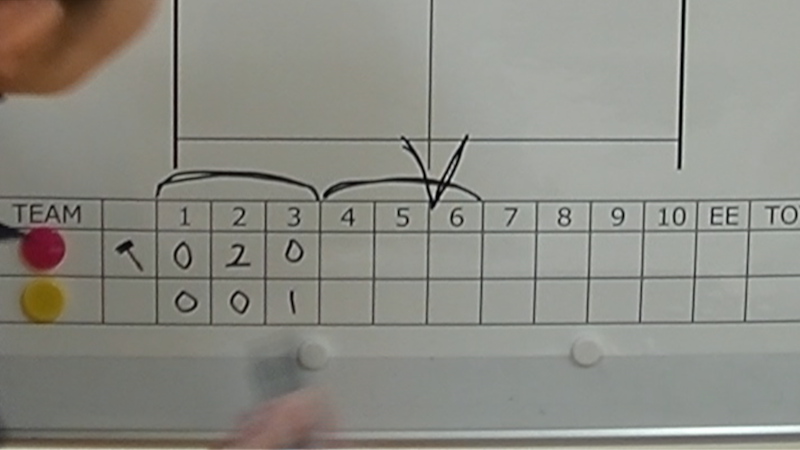
By halftime, for example, if a team is losing and the difference is not small, they want to be firmly tied by the end of the 5th end, or if a team may be able to hold a lead, for example, they want to head into the 6th end with a point or 2 in their favor.
As I mentioned before, players will be thinking from around the 5th end to the 8th end, about how to have the last stone on the 8th end in order to have it on the 10th end. Even if they are very calculated from the early stages of the game, it is not easy to make the game go the way they want it to so that they can have the last stone on the 8th end.
Therefore, it is preferable not to think that much in the early stages of the game, but rather to read the ice well, condition themselves, and create a situation in which they can attack at any time before entering the mid-game. In the mid-game, if a team can score 2 points firmly and let the opponent score 1 point, they will be in good situation to go into the 8th end.
It is very important in the play in mid-game to keep the point difference small when the 8th end starts. If a team is only 1 or 2 points behind, they can think that they can catch up or win the game well until the 10th end, it is very important to keep the points difference small until the 8th end.
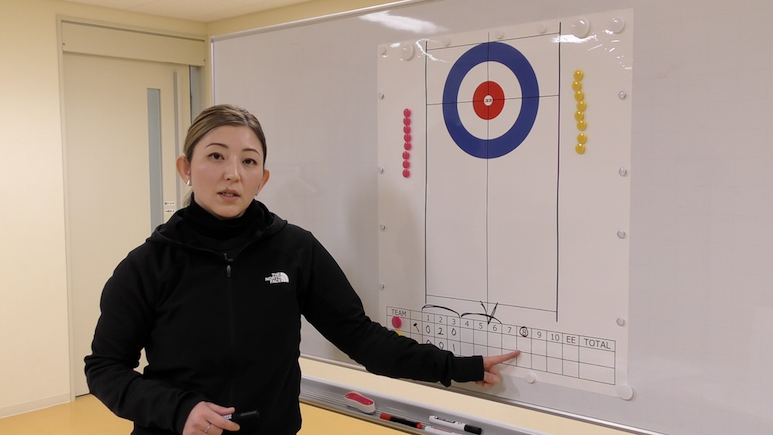
Part 2-2: Game plan toward the end of the game (Case of the small point difference)
Now, about the end of the game. When it comes to the end of the game, players think about how to finish the game towards the last 10th end. If a team is winning or losing a game by a narrow margin of 1 or 2 points, I don’t think they need to think too much about controlling the game until the 8th end. Ideally, by holding the last stone at the 8th end, a team should be able to score at the 10th end and win the game.
For example, when the score is tied at 2-2 at the end of the 5th end, the thing to think is still to score 2 points in the 6th end. In the 7th end, they can give 1 point to their opponent and have a lead by 1 point when going into the 8th end. Ideally, they should score 2 or 1 point in the 8th end. In this situation, the score would be 6-3 by adding 2 points.

If they can give the opponent 1 point again in the 9th end, the score will be 6-4. Then, in the 10th end, there will be 2 points up and they will have the last stone, which means they can almost win the game.

For next example, if the opponent scores 2 points. The score is now 4-4. In this case, they are still required to score 2 points in this 8th end. Then the score will be 6-4, 2 points up. If they play by 2 points up and let the opponent score 1 point in the next end, they will be able to enter the 10th end with 1 point up, which is not a bad situation.

Next, for example, they only scored 1 point in the 8th end. Even if that were the case, it is not a bad thing to have a 5-4 lead going into the 9th end. If the opponent scored 1 point in the 9th end, the 10th end is tied and they have the last stone. It is advantageous to have the last stone, and if they score even 1 point in the 10th end, they win. This idea is also not a bad scenario for Red team.
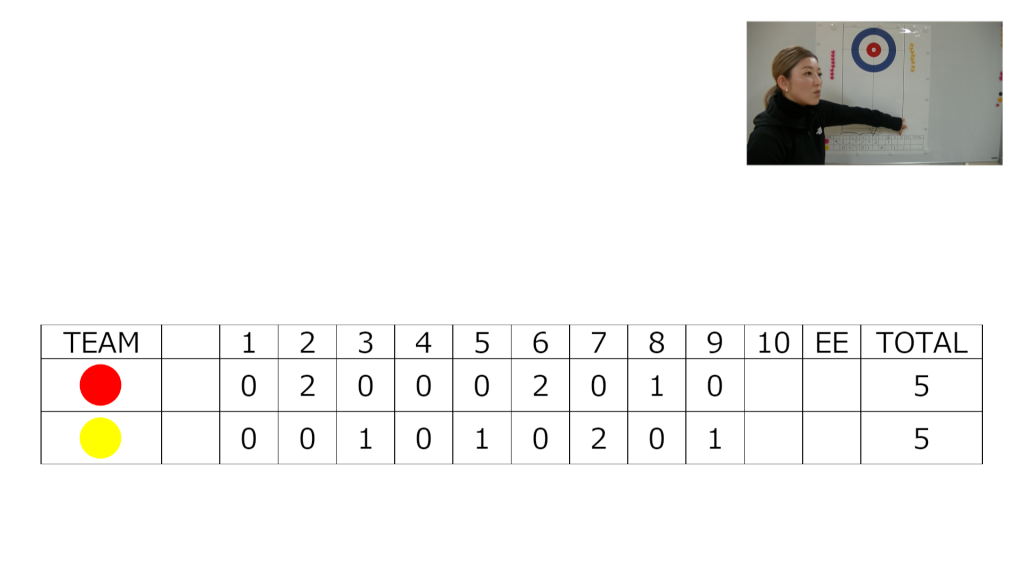
Although they do not have the lead, they have the last stone in the 10th end, so I think they have a good control of the game.
Furthermore, the opponent, of course, tries to get 2 points in the 9th end with the last stone. If the opponent scores 2 points in this end, Red is down by 1 point here, but has the last stone in the 10th end. They can tie the game by scoring 1 point and can enter into the extra end. Of course, it would be preferable if they could score 2 points in the 10th end.
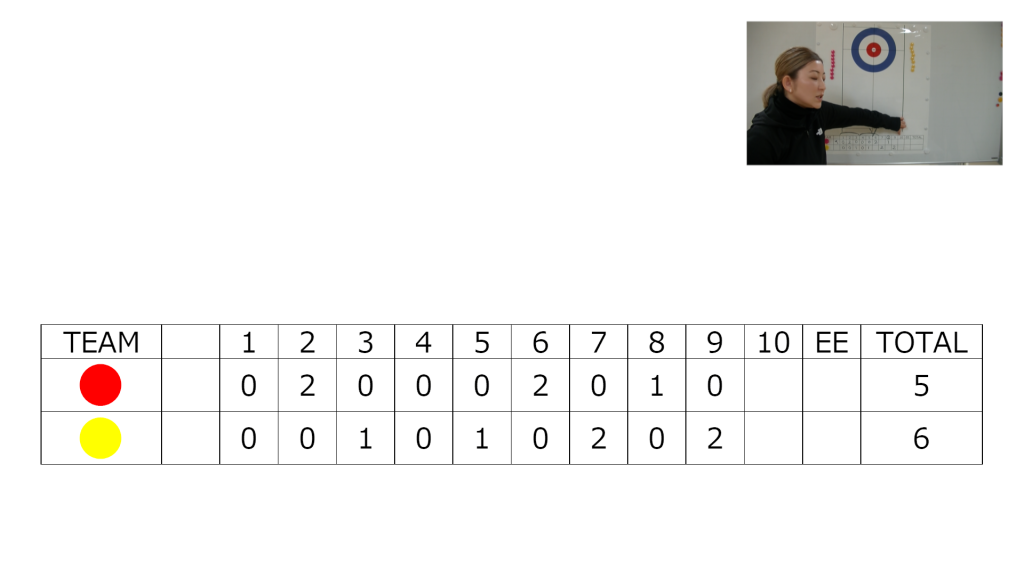
I have just spoken of such tactics from the perspective of Red team, but of course Yellow team will also play such tactics.
Of course, Yellow team does not always play as Red team would like to, and the opponent also wants the last stone at the 8th end, so let’s say Red team is tied by 4-4 while holding the last stone. For example, on the 8th end, the opponent has stolen. It is now 5-4. In the 9th end, the last stone comes. Red is 1 point down and has the last stone.

Then, how they want to finish the game on the 10th end is the point. It is not a bad choice to have a blank end in the 9th end. If 0-0 in the 9th end, they are down by 1 point, but they can have the last stone in the 10th end.

Now, for example, Red really tries 2 points in the 9th end, but only got 1. The score is tied at 5-5, and they do not have the last stone in the 10th end. In this situation, they have to aim to steal firmly in this 10th end.

Like this, if a team can go to the end of the games with a 1 or 2 points difference, it is the point how they want to finish the game. They want to lead by 1 point, or they think it is OK to be tied. They may be able to think it is no problem if they can have the last stone in the 10th end even if they are 1 point behind. In this example, the red team is losing by 5 to 4, but they have the last stone in the 10th end.
Players think about whether the situation is comfortable for them or not.
Of course, it would be nice if they could have a blank end at this 9th end. If they can have it in the 9th end, they can proceed to the 10th end with the tied score, holding the last stone.

However, even if they try to make a blank end, there is also the factor of how the opponent will play the game, so it is necessary to consider how they will play in the 9th and 10th ends while watching how their opponent will play.
It is important to always think of various patterns of how to finish the game in the 8th, 9th, and 10th end.
Part 2-3: Game plan toward the end of the game (Case of the large point difference)
For example, Red now has 3 points and Yellow has 7 points. Suppose that Red is now in the 8th end of the game, with 4 points behind. Red definitely aims to score 2 or 3 points on the 8th end with the last stone, but let’s say they scored 2 points. Red is still 2 points down after scoring 2 points.

Then, what should they do on the 9th and 10th end? For example, if Red gives the opponent 1 point on the 9th end, they can of course have the last stone on the 10th end, but Red are still down by 3 points, 8-5. Can Red win by 3 points down while having the last stone in the 10th end?

Then, for example, here’s another idea for the 9th and 10th end. Red is now 2 points down after the 8th end, then they have stolen 1 point in the 9th end. Stolen another point in 10th end as well. This ties the game at 7-7, so the game will not end and both teams will enter into the extra end.

Thus, if a team is losing by a fairly large margin, they may be in the situation to surely make a steal, or it would be undesirable even let the opponent score 1 point. If the point difference widens, it will be a tough situation to get 3 points even if they have the last stone in the 10th end, so in addition to closing the point difference by then, they will also have to consider whether to hold the last stone or not in each end. If a team reaches the end of the match with a large point difference, they have to take a lot of risks, so it is a good thing if they can stay 1 or 2 points behind in maximum by the mid-game as much as possible.
Conversely, if we think of it as the winning Yellow, they are up by 4 points at the beginning of the 8th end. Since they are already up 4 points, even if the opponent scores 2 points in the 8th end, Yellow still has 2 points up. They are up 2 points entering into the 9th and 10th end.

From Yellow’s point of view, it would be nice to be able to blank the 9 end. With 2 points up, Yellow can have the last stone in the 10th end. Or, as Yellow is 2 points up at the end of the 8th end, so even if the opponent stole 1 point in the 9th end, Yellow team still has the last stone with a 1 point advantage, 6-7, in the 10th end. This is not bad at all.

In curling, a team can win if they have scored only 1 more point than the opponent at the end of the 10th end, so they do not need to maintain a big lead, so it is easy to give their opponent 1 point if they have a big lead. So if a team leads a lot and reach the end of the game, they will be able to think and proceed with a lot of room in this seesaw game.
When there is a large point difference in the end of the game, the losing team wants to place many Guard stones.
The losing team will not be able to score without Guard stones, so they will try to put a lot of Guard stones. This form is when the team without the last stone is losing. For example, if a team with the last stone is losing a lot, they want to place a lot of Guard stones on the side while leaving the middle clear. Even if the opponent stone is in the House, for example, they will make sure to create stones that will lead to a second or third point later on. Like this. Yes, I think so.

After firmly creating such a form, they try to make the opponent’s stone in the House go out with their last stone, aiming for multiple points. So when the point difference is large, Guard stone becomes very important.
However, from the point of view of the team with the lead, it becomes easier to score points when there are many Guard stones, so in such case, Yellow with a large lead will remove Guard stones. Like this. In this way, by reducing as much as possible the number of Guard stones that can be hidden behind, they create a form that gives the opponent no chance.
You may see situations on TV, for example, where the stones in front are taken out, but the presence of Guard stones can be dangerous for the team in the lead, so teams with large leads reduce unnecessary Guard stones as many as possible.
Part 2-4: “Difficulty” of Game Plan
After shooting, Ms. Matsuzawa talked about the difficulty and importance of Game plan.
*Please note that there is some noise from the tidying up. Thank you for your understanding.
Curling is a sport, so if team gets more and more points like this, they will definitely win. However, in Curling, if a team scores points, they have to give up the last stone in the next end. When the opponent has the last stone on the next end, they want to avoid scoring by the opponent if possible, however, they cannot have the favorable last stone unless the opponent scores.
It is difficult to keep scoring all the time without the last stone, so players want to make the opponent score only 1 point, the minimum score, which is actually very difficult, and once they are able to do this, it is relatively easy to score 2 or 1 point when they have the last stone. This, how to give the opponent score only 1 point is the interesting part of Curling.

Because it is not easy to do so, players may attack poorly and, conversely, the opponent may score multiple points.
And, some players may often feel uneasy if they are not leading by a large point difference. Therefore, if they think that they want to score a lot of points as many as possible, their opponent often score many points conversely. Instead, it is quite difficult to think that even if they do not have many points, it is enough to win the game by only 1 point at the end of the game.
For example, players in the junior age may feel sometimes uneasy unless they have a large point differential. So, with that in mind, players will consider how to play in the 9th end. Of course, it would be best if they could enter the 10th end with the score up, but the point is whether or not they can think that it would be good if they could have the last stone at the 10th end with at least the same score, or even with 1 point down, as long as they can have the last stone at the 10th end. Once players can feel that way, it is just a matter of how to construct Game plan for that.

So, it is actually very important to be able to think that it is OK to win by 1 point at the end of the game, and then to finish the 9th end with a tie score, and then to have the last stone in the 10th end.
Q: Why is it so difficult to keep scoring points with not having the last stone?
It would be nice if a team could continue to make strong No. 1 stones that would never be taken out by the opponent at every end, but actually that is very difficult. In order to do that, they have to deliver the accurate shots every time and also the opponent has to miss their shots so many times, so it is very difficult to keep making No. 1 stones that are not taken out by the opponent.
Even if both teams are very skilled, players are human and of course make mistakes, and those mistakes are one of the most interesting aspects of Curling, and so, how to make the opponent make misses and how to deliver the stone to the point which may invite the opponent’s mistakes are the interesting aspects of Curling as well.
If players could place stones by hand like this, they would definitely be able to keep scoring points, and they might easily be able to give 1 point to the opponent and score 2 points for themselves, but as players are not allowed to place stones by hand, players make mistakes, such as unexpectedly hitting a stone that makes the shot interesting, therefore, it is precisely that Curling pertains mistake.

Of course, if a team can score all the time and sometimes get 3 or 4 points as a big end, they can win without worry, but I think Curling is interesting because it is not like that. The feeling that even a small point difference can be safe because the last stone they have is absolutely favorable, and, it’s like if they can have the last stone at the 10th end, which is absolutely advantageous, they are not afraid of anything.
Perhaps in other sports, the absolute security of a point difference at certain time may be that the opponent will never be able to catch up, but in Curling, if a team is leading or tied even with a small point difference with the last stone at the 10th end, I think it is quite advantageous if they can also have the security.
So I think Curling is interesting even if you only look at two points: how to give the opponent only 1 point, and how to have the last stone in this 10th end.
Share this content:
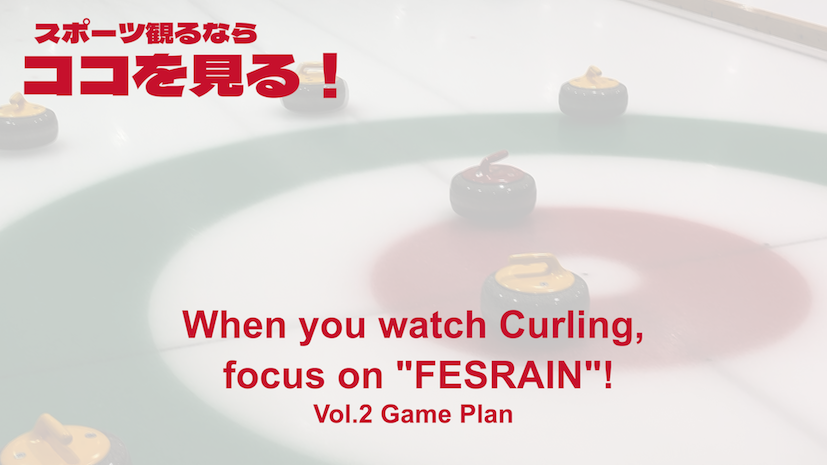
コメントを残す